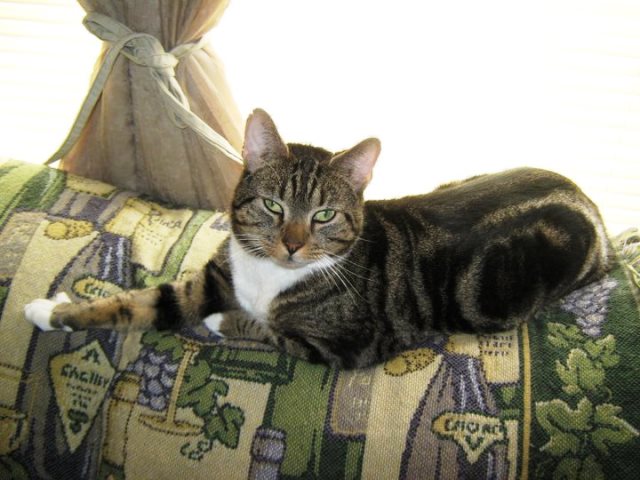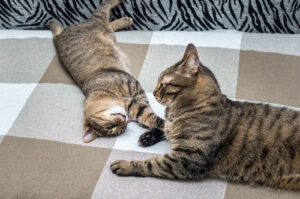By: Ashley L. LVT
Leonard came to our clinic as a stray. He was brought in by a client that found him outside her house. He along with several other cats came by her house to be fed, but one day he was malnourished and his tail broken and dragging behind him. This client knew he needed help so she scooped him up and brought him to us.
We amputated his devitalized tail and neutered him, in preparation for his new home. Unfortunately before he left the clinic we found out he was Feline Leukemia positive. This meant that not only was his future was a bit unclear, but he could not go into a home with other cats as had been planned.
While Leonard was in our hospital, I cared for him during his recovery and fell l in love with him. Since I didn’t have any cats already I decided to adopt him. While he was healing from his surgery I brought him back and forth to the clinic for recheck appointments, some of which required him to be sedated. All of Leonard’s rechecks went well and he went home with me and was issued a full bill of health.
As soon and I got Leonard home, it became apparent that he was going to be a kitty who was very interested in food. He got into any food that was left out on the counter, his own or otherwise. One weekend he got into some raisin bread that got left out accidentally. Since raisins are potentially toxic to dogs and cats, I brought him into the Emergency Veterinary Clinic in Brewer.
Once we arrived a technician checked him out and took his history. The doctor explained to me that not a lot is known about raisin ingestion in cats and that he was probably going to be fine. However he did mention that he and his technician noticed Leonard had a heart murmur while they were doing his exam. This was news to me. We had not noted a heart murmur the day Leonard came in or on any of his rechecks. The next day I brought Leonard to work to see Dr. Cloutier to check his heart.
A heart murmur is graded on a scale of 1 to 6 depending on how loud it sounds. During Leonard’s emergency clinic visit the doctor noted a grade 2. When Dr. Cloutier listened to his heart two days later it was a grade 4 and his heart rate was 280 beats per minute (normal is between 120-180 in cats).
Dr. Cloutier performed a cardiac ultrasound to check the anatomy of Leonard’s heart and how it was functioning. Dr. Cloutier concluded that Leonard had early signs of Hypertrophic Cardiomyopathy. He explained to me that Cardiomyopathy is actually quite common in cats, but that most people don’t find out about it until their cat is actually sick. It can come on fairly quickly and most times cats are asymptomatic until the condition gets really bad.
After the ultrasound Dr. Cloutier prescribed a medication to slow down Leonard’s heart rate and told me to keep him fairly quiet for the next couple weeks. When I brought him back for his first recheck after being on the medication for two weeks, Leonard’s heart rate had come down to 180 beats per minute and his heart murmur was a grade 2.
I monitor Leonard’s heart rate at home from time to time and with the help of the medication his heart rate stays between 120-140 when he’s home. It has been a year since I first learned Leonard had a heart condition, but thanks to Dr. Cloutier, we have been able to keep his heart rate and murmur under control and this year’s ultrasound was stable compared to last years. Cardiomyopathy is a serious condition, but animals can live long happy lives with lifestyle management and medications.





